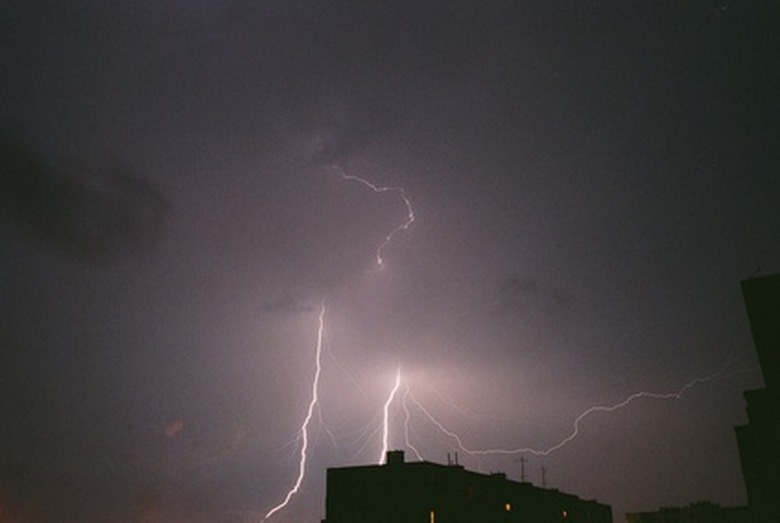The Effects Of Revolution & Rotation On Climate & Weather
The spinning of the Earth causes day to turn to night, while the full rotation/the revolution of the Earth causes summer to become winter.
Combined, the spinning and the revolution of the Earth causes our daily weather and global climate by affecting wind direction, temperature, ocean currents and precipitation.
Weather and Climate
Weather and Climate
The immediate conditions of the atmosphere–temperature, pressure, humidity, precipitation, cloud cover and wind–at a given place and time is what creates local weather.
Climate, on the other hand, is the long-term change of the atmosphere based on analysis of weather records over at least 30 years. The two factors that most strongly affect climate and weather are temperature and precipitation.
Effects of Revolution of the Earth: General Info
Effects of Revolution of the Earth: General Info
As the Earth revolves around the sun, its axis is tilted from perpendicular to the plane of the elliptic by ~23.45 degrees. It is on this axis that the earth rotates every 24 hours. Since the axis is tilted, the effects of revolution of the Earth is different for different parts of the globe.
Certain areas are tipped towards, or away from, the sun at different times of the year. This tilting causes the four seasons of the year. This tilting also creates opposite seasons in the Northern and Southern Hemispheres.
Effects of Revolution of the Earth: Seasons
Effects of Revolution of the Earth: Seasons
The Earth's seasons are not caused by the distance from the sun, but rather, by the tilt of the Earth's axis. Summer is warmer than winter because the sun's rays shine more directly than during winter, and also because the days are longer than the nights. During the winter, the sun's rays hit the Earth at a steeper angle, producing shorter days.
The equinoxes are days in which day and night are of equal duration, while the solstices are the days when the sun reaches its farthest northern and southern declinations, creating both the shortest and longest day of the year.
A Note on Tilt
A Note on Tilt
It was mentioned that the tilt of the Earth's axis combined with the revolution of the Earth causes the seasons as we know it to change and occur. Currently, this tilt is at an angle of approximately 23.5 degrees.
However, the angle/degree of this tilt is known to change over time. It can be at a maximum of 24 degrees and a minimum of 22.5 degrees.
When the Earth reaches this minimum angle, it plunges the Earth into an ice age. This cycle of tilt, also known as Earth's wobble, occurs in 40,000 year cycles, which leads to periodic ice ages that occur once ever 100,000 years as it takes.
So it's thanks to the specific tilt we are at now combined with the revolution of the Earth around the sun that leads to the seasons and changes in temperature that we experience.
Effects of Rotation of the Earth
Effects of Rotation of the Earth
When the Earth rotates on its axis, it prevents air currents from moving in a straight line north and south from the equator.
Instead, it results in one of the effects of rotation of the Earth: the Coriolis Effect. This deflects winds to the right in the Northern Hemisphere and to the left in the Southern Hemisphere.
Between 30 and 60 degrees latitude, the winds moving toward the poles curve east, forming the prevailing westerlies, which are responsible for many of the weather movements across the United States and Canada.
Wind Currents
Wind Currents
The global air circulation and the Coriolis Effect transfer warm air from low latitudes and cold air from high latitudes as wind moves from high pressure to low pressure. These global wind and pressure belts are important to Earth's climate, and determine the local geographical pattern of precipitation and temperature.
Yet, for small, local weather systems such as thunderstorms, the wind will flow directly from high pressure to low pressure and is not affected by the Coriolis Effect.
Cite This Article
MLA
Barber, David. "The Effects Of Revolution & Rotation On Climate & Weather" sciencing.com, https://www.sciencing.com/about-6737591-effect-revolution-rotation-climate-weather/. 22 November 2019.
APA
Barber, David. (2019, November 22). The Effects Of Revolution & Rotation On Climate & Weather. sciencing.com. Retrieved from https://www.sciencing.com/about-6737591-effect-revolution-rotation-climate-weather/
Chicago
Barber, David. The Effects Of Revolution & Rotation On Climate & Weather last modified March 24, 2022. https://www.sciencing.com/about-6737591-effect-revolution-rotation-climate-weather/
